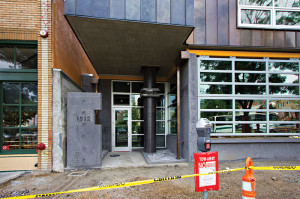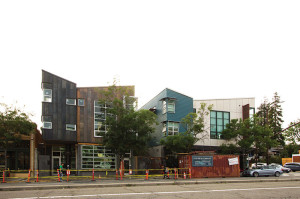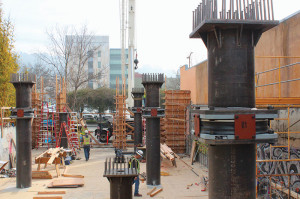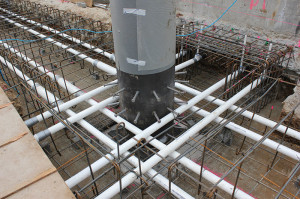It is not often that a new building’s structural engineer is also its developer – and the synergies arising from this pairing are equally rare. How can seemingly opposing priorities and objectives combine positively? How can a developer’s challenges transform into innovative seismic engineering opportunities? The Tipping Structural Engineers (TSE) mixed-use project at 1908 Shattuck Avenue in Berkeley, CA, is that unique result of the interdependence between creative engineering and real-estate development strategies.
1908 Shattuck Avenue
TSE – whose existing offices at 1906 Shattuck are immediately adjacent – developed and designed the project to accommodate their increasing numbers. The structure accommodates a restaurant-brewery at street level and an office space designed for 25 people on the second and third floors. Its superstructure comprises two stories of wood-frame construction, totaling about 4,800 square feet, with a lateral system consisting of a series of distributed wood shear walls sheathed with half-inch plywood. Supporting the superstructure are six cantilevered columns and a 14-inch-thick post-tensioned concrete podium slab. Lastly, a series of crossing grade beams measuring 6 feet wide by 3 feet deep make up the building’s foundation system.
The downtown Berkeley infill site, measuring only 39 feet by 90 feet in plan, is less than a mile west of the Hayward Fault, considered to be the most active fault in the country, with a 31 percent chance of releasing a magnitude 6.7 earthquake in the next 30 years. A primary goal of the project was to develop a structural system that reflected quintessential Tipping engineering – effective, cost-efficient, project-specific design thinking. Given this project’s location, seismic isolation was quickly identified as the best way to achieve this goal, resulting in perhaps the smallest isolated commercial building in the United States.

Column and bearing are exposed to public view. The isolator will be painted yellow to match the yellow stripe, indicating movement and the isolation plane.
Planning and Development Challenges
The City of Berkeley is well-known for its stringent zoning codes and building requirements. For 1908 Shattuck, a combination of these limited the size of the building to a maximum of 7,500 gross square feet, its height to 40 feet, the number of stories to 3, and the use of the ground floor space to only retail, which constrained the office space to the upper two floors. Also, the zoning code would have dictated a 25-foot setback at the west side of the property (which borders a residential lot), losing TSE almost 2,500 square feet of usable space. To clear this zoning hurdle and maximize the size of the new building, the developer-engineers decided to merge 1906 and 1908 Shattuck into one property, which drastically reduced the setback requirements. Furthermore, the merger allowed both buildings to share a common entry (from the street to the second floor) as well as the existing building’s elevator and above-ground parking garage.
Idiosyncratic Isolation
Once the basic geometry of the building was set and the planning and development issues resolved, the engineers turned to designing the seismic isolation system, which became the single most compelling feature of 1908 Shattuck.
Isolation bearings are typically installed below grade, hidden from view, requiring intensive – and expensive – foundation work. As it happened, previous construction had left retaining walls on three sides of the lot to accommodate a grade change of about eight feet over the depth of the site. This fortuitous condition spurred the engineers to envision alternative isolation configurations. They decided to expose the bearings. Spliced into the ground-floor columns ten feet above grade, they are visible to the patrons of the restaurant. The façade was designed so that one column stands outside, viewable by the public from the street. Traditional base isolation systems require a ground-level “moat” that allows the isolated building freedom to move during an earthquake. Splicing the isolation bearings into the columns above grade resulted in an atypical isolation plane requiring a different approach: ground-floor walls cantilever from the foundation and an isolation moat was designed at the second story. All in all, this idiosyncratic isolation design resulted in a more cost-efficient solution than traditional below-grade installations, an outcome sweet to any developer’s ears.
Because of the site’s proximity to the Hayward fault, practice would dictate isolation bearings with an allowable horizontal movement of roughly 36 inches. Installing such bearings would have resulted in a building 33 feet wide at the maximum. Given the small lot size and the architectural program, TSE was reluctant to forego so much real estate – having originally planned for a 35-foot-wide building. The engineers recognized that the only way to achieve this would be to employ isolators with a smaller allowable movement, specifically, 24 inches. To that end, they worked with Earthquake Protective Systems (EPS) in Vallejo, CA, to customize six stock triple-pendulum bearings.
Lock-Up Potential and Mitigation
The next step was to test a customized bearing. EPS ran multiple ground motions at maximum-displacement earthquake (MCE) and design-basis earthquake (DBE) hazard levels. They confirmed that the median displacement under DBE simulations would be 11 inches with an associated shear force of 40 kips, and under MCE simulations, 22 inches with an associated shear force of 50 kips. Significantly, two of fourteen analyses caused the isolator to “lock up,” or reach the 24-inch allowable displacement capacity, resulting in a shear force of 150 kips. To account for the slight probability of lock-up, the engineers designed the cantilever columns with a diameter of 24 inches instead of 20 inches, which would allow them to remain elastic at lock-up. Further, to analyze the effect that locking up would have on the superstructure, they modeled every wood wall. Based on those results, they concluded that all the walls had to be sheathed with plywood, in some cases on both faces, to achieve the desired elastic behavior. Lastly, to allow the footings to yield, displace, and then self-center in the event of an earthquake force larger than the lock-up, the foundation’s grade beams were reinforced with post-tensioned high-strength steel rods. All these design strategies added cost to the project; however, the gain in the programmable square footage was a tradeoff well worth the expense.
Statewide Seismic Monitoring
TSE submitted 1908 Shattuck to the California Strong Motion Instrumentation Program for inclusion in the statewide monitoring system. It was accepted on the basis of two unique aspects: 1908 will be the first isolated building employing a wood shear-wall lateral system; and the adjacent existing office building, constructed about twenty years ago, is structurally identical to 1908, with the exception of the isolation bearings. Both buildings are hard-wired to transmit data via satellite to a data center in Sacramento, CA. The new building is equipped with sixteen, three-axis sensors, the older building with six. The sensors were positioned to capture the translation and rotational components of each building’s seismic response.
Lessons for Everyone
The knowledge and advantages gained in planning, designing, and constructing 1908 Shattuck need not benefit only the developer-engineers at TSE. In fact, Steven Tipping is hopeful that each innovation and design strategy inspires others, and ultimately informs the profession. As engineers go about their practice, learning to think like a developer and being empathetic to a developer’s project goals can multiply the possibilities at their disposal – both in serving clients and in creating cutting-edge engineering solutions. “When structural engineers abandon their silos to ask the bigger questions, the profession can only grow and flourish,” advises Tipping. “What’s best for the whole project? What’s best for all the players – the owner, the architect, the other disciplines, the trades? How can our work improve the built environment at large?”▪
Project Team
Owner: Steven B. Tipping
Structural Engineer: Tipping Structural Engineers (initiated as Tipping Mar)
Architect: Fernau and Hartman Architects
General Contractor: Oliver and Company



